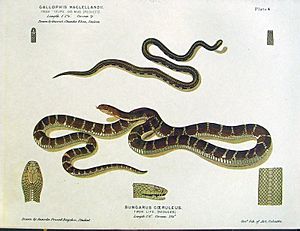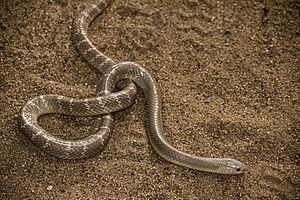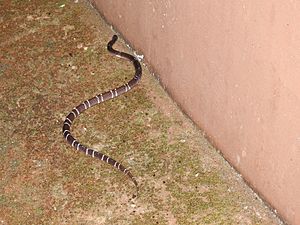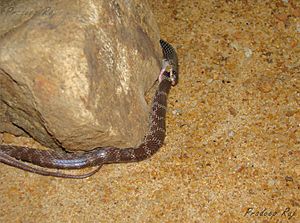Common krait facts for kids
Quick facts for kids Common krait |
|
|---|---|
 |
|
| Scientific classification | |
| Genus: |
Bungarus
|
| Species: |
caeruleus
|
| Synonyms | |
|
Pseudoboa caerulea Schneider, 1801, Bungarus candidus var. Cærulus Boulenger, 1896 |
|
The common krait (Bungarus caeruleus) is a very venomous snake. It is also known as the Bengal krait. This snake lives in the Indian subcontinent. It is one of the "Big Four" snakes. These four types of snakes cause the most snakebites in Pakistan, India, and Bangladesh.
Contents
About the Common Krait
Common kraits are usually about 0.9 meters (3 feet) long. Some can grow up to 1.75 meters (5.7 feet). Male kraits are longer than females. Their tails are also longer.
The krait's head is flat. Its neck is not very clear. Its body is round and gets thinner towards the tail. The tail is short and round. Kraits have small eyes with round pupils. Their scales are very shiny. They are arranged in 15-17 rows. The scales along their back are larger and shaped like hexagons.
What Do Common Kraits Look Like?
Common kraits are usually black or bluish-black. They have about 40 thin, white stripes across their body. These stripes might be hard to see near the head. Young kraits have very clear white stripes. Older kraits might have white spots instead of full stripes. Sometimes, a white spot can be seen near their eyes. Their upper lips and belly are white. Very rarely, an albino krait (all white) can be found.
Where Common Kraits Live
This snake lives in many places. You can find it from Sindh to West Bengal in India. It also lives throughout South India and Sri Lanka. They can be found in areas up to about 1,600 meters (5,200 feet) high. Common kraits have also been seen in Afghanistan, Iran, Bangladesh, and Nepal.
Common Krait Habitats
Common kraits live in many different places. They can be found in fields and low scrub jungles. They also live near places where people live. Kraits often hide in termite mounds or piles of bricks. They also like rat holes and even inside houses. You can often find them near water.
How Common Kraits Behave
Common kraits act differently during the day and night. During the day, they are slow and usually calm. They often hide in holes or under things. This means you rarely see them during the day. They often curl their body into a loose ball. They keep their head hidden inside the ball. When they are in this ball shape, you can handle them a bit. But if you handle them too much, they might bite.
At night, kraits are very active. If they feel bothered, they might hiss loudly. They might also stay very still. Sometimes, they will bite if something annoys them.
Krait Defenses and Bites
When a krait feels threatened, it coils up. It hides its head and flattens its body. It might also make quick, jerky movements. It can even lift its tail. Kraits do not like to bite. But if they do, they often hold on for a while. This allows them to inject a lot of venom. They can become aggressive at night if they feel threatened. This is because night is when they are most active.
The common krait causes many snake bites in India. It is responsible for the second-highest number of bites from a single snake species. In Bangladesh, it causes 28% of all krait bites.
What Common Kraits Eat
The common krait mainly eats other snakes. It will even eat other kraits, including young ones. They also eat small mammals like rats and mice. Lizards and frogs are also part of their diet. Young kraits are known to eat arthropods (like insects) and small, thin snakes called blind snakes.
Common Krait Venom
The common krait's venom is very strong. It mostly has powerful neurotoxins. These toxins cause muscles to become paralyzed. This means the muscles stop working. The venom affects how nerves send messages to muscles.
A small amount of venom can be very dangerous for humans. About 2-3 milligrams of venom can be deadly. The average krait bite injects about 10 milligrams of venom.
Dangers of a Krait Bite
Kraits are active at night. So, they usually do not meet humans during the day. Most bites happen at night. Often, a krait bite causes little or no pain. This can make a person think the bite is not serious. But it is very serious.
People who are bitten often feel severe stomach cramps. Then, their body slowly becomes paralyzed. If a person does not get help, they can die about 4-8 hours after the bite. Death happens because the breathing muscles stop working. This leads to suffocation.
During the rainy season, kraits sometimes come into dry houses. If someone is bitten by a krait while sleeping, they might not even know it. The bite can feel like an ant or mosquito bite. A person could die without waking up. Krait bites usually do not cause much swelling or redness. This can sometimes help identify the snake if it was not seen.
A few hours after a bite, the muscles in the face might tighten. The person might not be able to see or talk. If not treated quickly, the person can die from breathing problems within 4-5 hours. Studies show that 70-80% of people who do not get treatment can die. In Bangladesh, the common krait causes more than half of all snake bite deaths.
See also
 In Spanish: Krait común para niños
In Spanish: Krait común para niños





